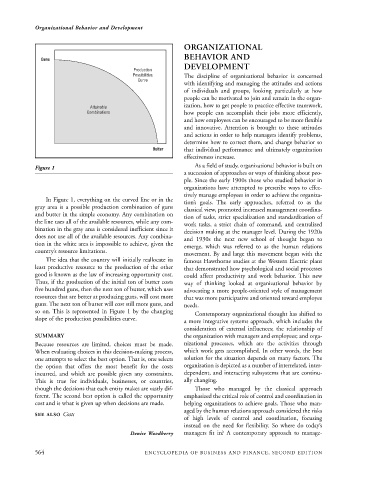Page 587 - Encyclopedia of Business and Finance
P. 587
eobf_O 7/5/06 3:17 PM Page 564
Organizational Behavior and Development
ORGANIZATIONAL
BEHAVIOR AND
Guns
DEVELOPMENT
Production
Possibilities The discipline of organizational behavior is concerned
Curve
with identifying and managing the attitudes and actions
of individuals and groups, looking particularly at how
people can be motivated to join and remain in the organ-
ization, how to get people to practice effective teamwork,
Attainable
Combinations how people can accomplish their jobs more efficiently,
and how employees can be encouraged to be more flexible
and innovative. Attention is brought to these attitudes
and actions in order to help managers identify problems,
determine how to correct them, and change behavior so
Butter that individual performance and ultimately organization
effectiveness increase.
As a field of study, organizational behavior is built on
Figure 1
a succession of approaches or ways of thinking about peo-
ple. Since the early 1900s those who studied behavior in
organizations have attempted to prescribe ways to effec-
tively manage employees in order to achieve the organiza-
In Figure 1, everything on the curved line or in the
tion’s goals. The early approaches, referred to as the
gray area is a possible production combination of guns classical view, promoted increased management coordina-
and butter in the simple economy. Any combination on tion of tasks, strict specialization and standardization of
the line uses all of the available resources, while any com-
work tasks, a strict chain of command, and centralized
bination in the gray area is considered inefficient since it
decision making at the manager level. During the 1920s
does not use all of the available resources. Any combina- and 1930s the next new school of thought began to
tion in the white area is impossible to achieve, given the emerge, which was referred to as the human relations
country’s resource limitations.
movement. By and large this movement began with the
The idea that the country will initially reallocate its famous Hawthorne studies at the Western Electric plant
least productive resource to the production of the other that demonstrated how psychological and social processes
good is known as the law of increasing opportunity cost. could affect productivity and work behavior. This new
Thus, if the production of the initial ton of butter costs way of thinking looked at organizational behavior by
five hundred guns, then the next ton of butter, which uses advocating a more people-oriented style of management
resources that are better at producing guns, will cost more that was more participative and oriented toward employee
guns. The next ton of butter will cost still more guns, and needs.
so on. This is represented in Figure 1 by the changing Contemporary organizational thought has shifted to
slope of the production possibilities curve.
a more integrative systems approach, which includes the
consideration of external influences; the relationship of
SUMMARY the organization with managers and employees; and orga-
Because resources are limited, choices must be made. nizational processes, which are the activities through
When evaluating choices in this decision-making process, which work gets accomplished. In other words, the best
one attempts to select the best option. That is, one selects solution for the situation depends on many factors. The
the option that offers the most benefit for the costs organization is depicted as a number of interrelated, inter-
incurred, and which are possible given any constraints. dependent, and interacting subsystems that are continu-
This is true for individuals, businesses, or countries, ally changing.
though the decisions that each entity makes are vastly dif- Those who managed by the classical approach
ferent. The second best option is called the opportunity emphasized the critical role of control and coordination in
cost and is what is given up when decisions are made. helping organizations to achieve goals. Those who man-
aged by the human relations approach considered the risks
SEE ALSO Costs
of high levels of control and coordination, focusing
instead on the need for flexibility. So where do today’s
Denise Woodberry managers fit in? A contemporary approach to manage-
564 ENCYCLOPEDIA OF BUSINESS AND FINANCE, SECOND EDITION

